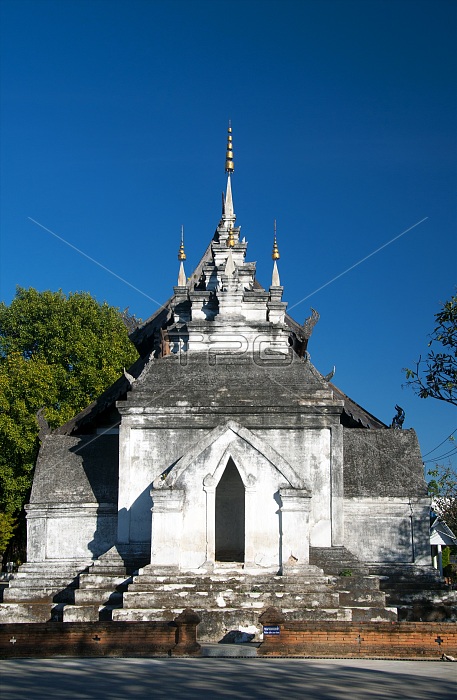
Wat Prasat (鉊抉萵鉊?鉊?葡鉊芹葡鉊? dates back at least as far as the 16th century CE, and is probably still older.
The most important building in the temple complex is the old viharn, which dates from 1823 but was tastefully renovated in 1987. Built in traditional and distinctively Lan Na style, the viharn is built of skillfully-crafted teak wood panels on a whitewashed brick and stucco base. The main entrance, which naturally faces east, is reached by a low flight of steps flanked by naga balustrades.
The interior of the temple is elegantly understated, with tall teak pillars supporting a low-slung, tiled Lan Na roof. Unusually, at the western end of the building where the altar would usually be, there is instead an elaborately decorated entrance to the short ???unnel??leading to the contiguous chedi, the latter housing a large gilded Buddha image that is only partly visible from the viharn due to its size.
A number of Buddha images sitting on raised pedestals flank the entrance to the tunnel. All but one are of stucco, but the image closest to the tunnel entrance, on the right hand pedestal, is of cast bronze and dates from 1590 during the reign of King Nawrathaminsaw (r. 1578-1607), the first Burmese ruler of Chiang Mai.
King Mengrai founded the city of Chiang Mai (meaning "new city") in 1296, and it succeeded Chiang Rai as capital of the Lanna kingdom. Chiang Mai sometimes written as "Chiengmai" or "Chiangmai", is the largest and most culturally significant city in northern Thailand.
| px | px | dpi | = | cm | x | cm | = | MB |
Details
Creative#:
TPG32690507
Source:
達志影像
Authorization Type:
RF
Release Information:
須由TPG 完整授權
Model Release:
No
Property Release:
No
Right to Privacy:
No
Same folder images:

 Loading
Loading